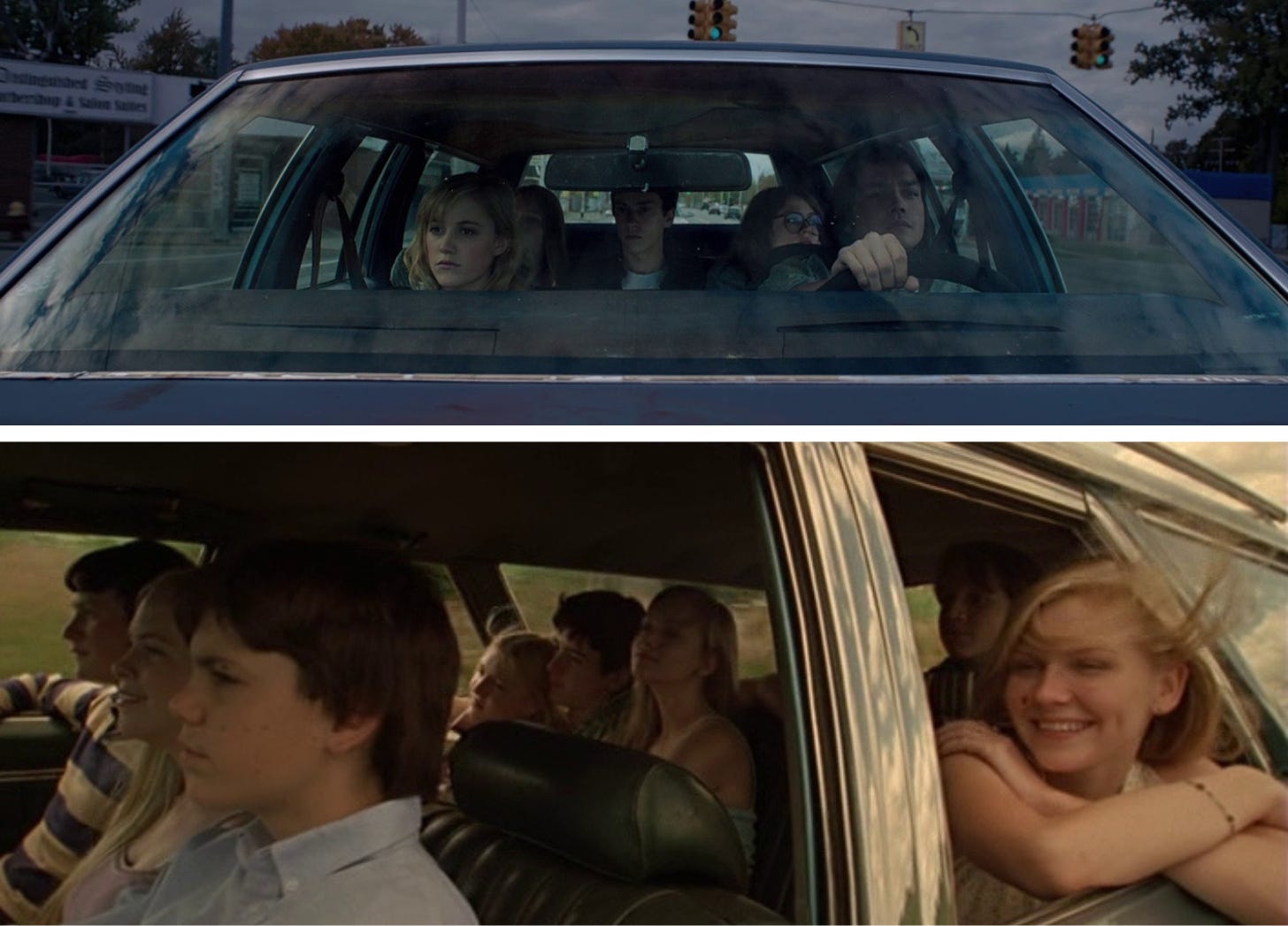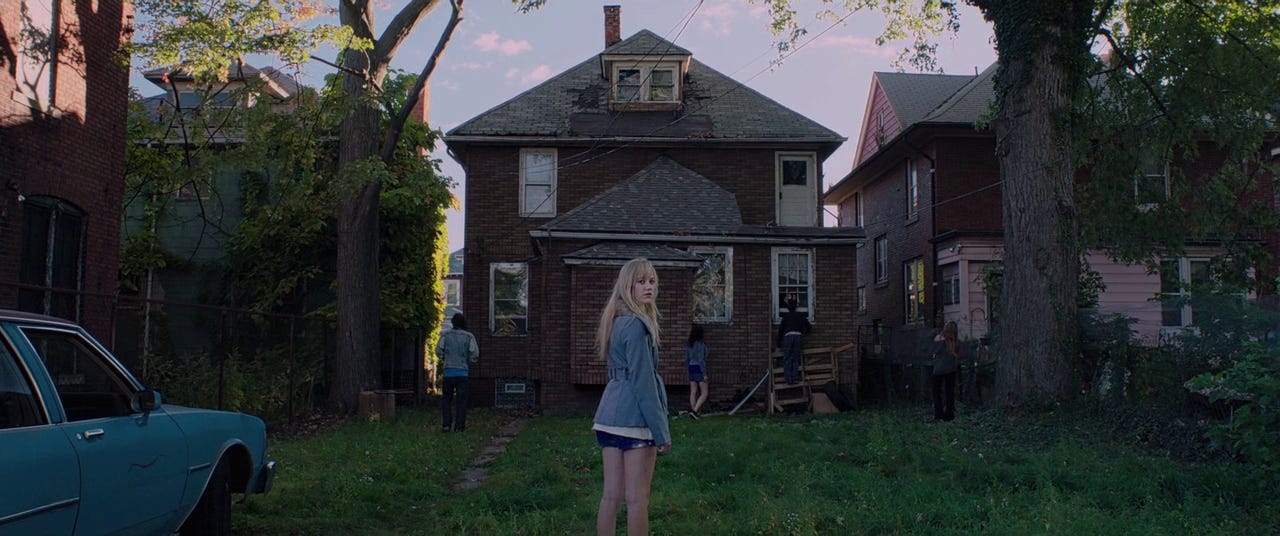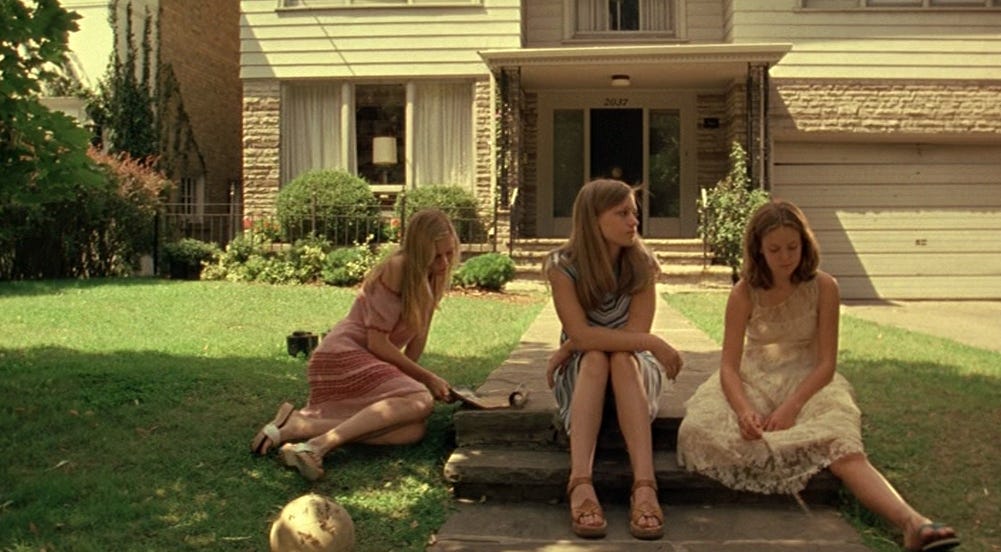“I think that if one is faced by inevitable destruction—if a house is falling upon you, for instance—one must feel a great longing to sit down, close one's eyes and wait, come what may…”
- Fyodor Dostoevsky, “The Idiot”
The hand of a teenage girl hangs out the back door of a Plymouth Gran Fury, cherry red fingernails grazing the white blooms of roadside Baby’s Breath.
“It's funny,” the girl says. “I used to daydream about being old enough to go on dates and drive around with friends in their cars… It was never about going anywhere... just having some kind of freedom I guess. Now we're old enough, but where the hell do we go right?”
In another scene, in another era, a gaggle of over-eager boys cluster around the front door of another blonde teenage girl’s house. This one coyly smokes a cigarette; a knowing smirk plays across her lips.
“We got a car, a full tank,” one of the boys says. “We’ll take you anywhere you wanna go.”
Ahead of the girls is a future supposedly full of freedom, the kind promised by open roads that lead “wherever they wanna go,” boys and men willing to chauffeur them, gas tanks full of petroleum made less crude, more refined just for their privileged use.
But now, behind the girl in the car, a man approaches with a chloroform-soaked handkerchief, and behind the girl with the cigarette, one sister is stringing herself up from the rafters while the other swallows a fistful of pills. And all across suburban America in cars parked by roadsides and idling in driveways, in neat brick houses flanked by infected elm trees, in the piercing blue of over-chlorinated above-ground swimming pools, freedom seems only to signal death.
Despite the fact that more than half of Americans live in them, the sub-division style of development that began to creep across our landscape in the mid-twentieth century retains an anxiety-inducing presence in our cultural imagination. From Halloween (1978) to Donnie Darko (2001) to Get Out (2017), the suburbs have been the preferred setting for countless horror films.
Just the idea of suburbia, for some, calls to mind a whole range of symptoms indicative of post-modern American ickiness. The eerie aesthetics of assimilation, the consumerist banality of a strip mall—nods to a history of white flight, racial segregation, environmental destruction, the soul-crushing conveyor belt of a 9 to 5 routine, the ‘good fences make good neighbors’ mentality that keeps the HOA at bay. Little boxes made of ticky tacky, and they all look just the same.
So, It Follows joined a legacy of horror grounded in suburbia when it came out in 2014, a hit with audiences and critics. In the film, 19-year-old suburbanite Jay has sex with a man who, in effect, curses her. The curse is that she will be followed by slow-moving creatures who want to kill her. They take on human form, but are invisible to others. In order to get rid of these followers, she’s told she has to pass the curse on to someone else, via sex.
The film takes place outside of Detroit, and bears all the hallmarks of American suburbia as seen through the lens of its teenage inhabitants. Two sisters and their two friends lounge in bedrooms and living rooms and on cement patios; they watch mindless TV and wander the streets alone, wearing short shorts, smoking clandestine cigarettes, sipping soda out of big plastic cups. They gather on the playground after-hours; the swings a set piece in the juvenile drama of their lives. One girl reads Dostoevsky’s “The Idiot” on a smart phone shaped like a pink shell.
This is a similar landscape to the one the Lisbon girls, of Sofia Coppola’s The Virgin Suicides (1999), inhabit in the 1970s. There are numerous similarities between the two films. The Virgin Suicides also takes place in the suburbs outside of Detroit. The protagonist in both is a pretty blonde exploring her sexuality for the first time, encountering the danger that seems inherent to feminine beauty.
Yet, the girls in The Virgin Suicides are smothered by adult supervision. They are kept under strict watch by an overbearing mother who does not allow them to ride in cars with other teens, date, become cheerleaders, or, eventually, leave the house at all. Other parents in The Virgin Suicides also seem to be ever-present; they come together to rip out a fatal fence in the wake of the first sister’s suicide, chaperone their children at parties and school dances, and throw comically problematic debutante “coming-out” parties for their daughters in country clubs.
By contrast, in the It Follows version of suburbia, the kids are on their own. Not once does a parent step in as their children steal away in cars on overnight trips, date strange men, and—in one instance—literally shoot each other with a gun. The adults in this film are mostly drunk or invisible, leaving the adolescents to fend for themselves against the horrors of the outside world. Ironically, the effect—over-parenting, lack-luster parenting—is essentially the same.
If The Virgin Suicides presents a vision of suburbia that represses, traps, and ultimately destroys beauty and sexuality, then It Follows presents the flip side of that coin—a suburbia inhabited by a population that’s grown comfortable operating under the illusion of freedom. The absent parents of It Follows have sorted out the American dream, now they are free to let their children live in it. Their daughters, under-supervised and over-privileged, struggle with the anxiety of knowing there is danger in the world, if not at their doorsteps.
“I was drawn to the movie as a way of making a film about dread and anxiety,” It Follows director Robert David Mitchell told Slate. “I think it’s more about the feeling of waiting for something. You understand how terrible things can get, but you don’t know when it’s going to happen, or how, or where.”
In the 20th century, a perfect storm of suburbanization brewed in the U.S. FDR’s New Deal creations, including the Home Owner’s Loan Corporation (HOLC) and the Federal Housing Association, post-war economic prosperity, the invention of the streetcar and automobile, and the accessibility of credit cards allowed more people in the U.S. to buy homes than ever before.
Suburban communities of greater than 10,000 people grew 22.1 percent between 1940 and 1950, while planned communities grew 126.1 percent, according to The American Yawp. Over the next 20 years, 83 percent of population growth in the U.S. took place in the suburbs.
The history of personal transportation is intimately tied with the history of the ‘burbs. Newly affordable vehicles and the construction of highways made it possible for more people to live outside of cities—together, they furthered the individualism that has since become an indelible symbol of American freedom.
“A car owner need not worry about train schedules,” writes Ted V. Mcallister. “He could leave at 10 am, or he could leave at 10:15 am. He was master of his time… To Americans at mid-century, the car, perhaps more than any other object, represented freedom—the freedom of the individual.”
No city better represents the coupling of the American suburb and the automobile better than Detroit. As a manufacturing and automotive hub, Detroit flourished in the late 19th and 20th centuries. With increasing affluence came a desire on the part of its wealthier residents to leave the city and spread out to greener pastures.
“Twenty years ago there was a sharp dividing line between living in the city and living in the country,” wrote one reporter in a 1928 edition of The Detroit Free Press. “Now, however, the situation is gradually reversing itself; for today the better class of new homes are being built in the suburban areas, away from the noise and confusion of the city. They have every city convenience available with perfect roads for the motor car.”
What followed is a history many people know well: Redline mapping in 1939 targeted neighborhoods in the Detroit Metro Area that were inhabited by or even located near communities of color, marking them “hazardous” to investment. Neighborhoods that were not racially segregated received lower HOLC grades, while government appraisers gave better grades to wealthier, non-immigrant white neighborhoods, many of which had segregation baked into zoning, housing, and schooling policies. The Detroit Metro Area became the most racially segregated city in the country. Such horror films as Barbarian (2022) depict the depleted, deserted suburbs that have resulted from Detroit’s boom and bust.
Detroit was the automotive capital of the United States; the city where the first-ever “affordable” family car, the Ford Model T, was born and manufactured. It wasn’t just that suburban economic stability relied on the automobile, employing thousands all up and down the ladder, the car also became vital to many citizens’ cultural lives. The city exported this individualistic model of freedom, making it possible for people country-wide to visit newly built drive-in movie theaters and drive-in restaurants, and travel across the country on “road trips.”
“Shopping centers opened with the auto-driver in mind, new motels catering to the car-traveler popped up along desolate highways, and any number of new amusement destinations, from Disneyland to Rock City, opened to take advantage of a nation vacationing on wheels,” McAllister writes.
There was a downside to this new car-enabled freedom; a paradoxical dependency that kept people stuck in the lifestyles that had once felt revolutionary. A car was no longer just a key unlocking previously undiscovered sources of pleasure, employment, and comfort. It became a necessary operating cost, among others, to sustain the suburban lifestyle.
“A car gave a father the freedom to buy a house in the suburb while keeping his job in the city,” McAllister writes. But, “after years of commuting, this same father was likely to feel trapped. He couldn’t possibly give up his car since he had organized his life around it. Freedom lost.”
The Virgin Suicides is not necessarily a horror film, but it is full of foreboding. The very first scene in the movie is of an elm tree being marked for removal. Endangerment is a recurring motif—not just of wildlife, but of the lifestyle the film’s humans have come to enjoy.
"Everyone dated the demise of our neighborhood from the suicides of the Lisbon girls,” the narrator says, near the film’s end. “People saw their clairvoyance in the wiped-out elms, the harsh sunlight, the continuing decline of our auto industry.” This overture clarifies that we, the viewers, are looking at the neighborhood from a future where it no longer exists. The Lisbon girls perish alongside the dream of suburbia.
It Follows, which has no distinct time setting, places us in a bleaker suburban enclave, with more slippages between their protected world and what lays beyond.
“When I was a little girl my parents told me I wasn't allowed to go south of 8 mile,” says Jay’s friend Yara. “I didn't even understand what that meant. It wasn't until I got a little older that I realized that was where the city started and the suburbs ended. I started thinking how weird and shitty that was. I had to ask permission to go to the state fair with my best friend and her parents just because it was a few blocks past the border.”
The man who gives Jay the follower-sickness to begin with has been staying in a decaying old house in the “inner city.” To get to his house, Jay and her friends pass the scenery of a depleted Detroit. The script describes the drive south along Interstate 75: “broken buildings wave from the edge of the expressway, gutted plants momentarily block out the harsh sun. Dangerous streets and alleyways loom along their path.” This is the future The Virgin Suicides foretold—the rot of separatism beginning to spread.
As the Lisbon girls are isolated further and further from society, Lux Lisbon seeks freedom via endless sexual encounters on the roof of her home, all attempts to be held, rather than trapped. But because of her restricted life, these encounters can only be brief and unsatisfying. At the end of each interaction, she is forced to return to her captivity. She kills herself, ultimately, in a car.
The end of It Follows finds Jay hand in hand with the boy who has loved her from the movie’s start. It’s not a happy ending, per se, but it is one in which she still has the love and support of her friends. Everyone survives. Without even being able to see the monsters, the teenagers band together to come up with schemes to liberate Jay from her torture. This is, interestingly, an inversion of the “final girl” narrative. Rather than ending the movie alone and alive, Jay finds safety in togetherness. She isn’t the lone virgin who survives by virtue of her purity. She lives because she is loved.
“Even though the characters open themselves up to danger through sex, it's the act of living that opens themselves up to danger,” Mitchell said of It Follows. “And it's sex and love that—at least temporarily—allow us to live in the moment, and keep death at bay.”
Last week I watched Donald and Melania exit their motorcade and enter the White House. He is flanked, in his second term, by all the makings of a techno-oligarchy, the boy geniuses of early 2000s Silicon Valley all grown up and taking their place at the right hand of power while California burns.
Ecologists and land management officials have pointed to the haplessness of the built environment—residential areas encroaching further and further into places where regular burns are necessary to maintain the forest’s natural balance.
“The problems of today were created many years ago when officials approved large-scale development in high-risk areas without adequate safeguards,” J.P. Rose, an attorney for the Center for Biological Diversity, told NBC News.
For some time, we have enjoyed the convenience and splendor of suburban sprawl. But it has taken sacrifice to our cities, our forests, our world to sustain that convenience.
The ideas we have about freedom no longer make sense. We still rely on the old individualist markers: cars flying down open roads, a lone eagle spreading its wings against a clear blue sky. But the cars on the highways are filling the atmosphere with fumes, the birds are fleeing with the smoke of our smoldering neighborhoods. Now we're old enough, but where the hell do we go, right?
Many of us will begin looking for new symbols of freedom—the kind that come not from individual release, but collective liberation. We’ll imagine a version of American freedom that is the opposite of manifest destiny, one grounded in digging deeper into our struggles rather than fleeing from them to a place where the grass will surely be greener (for some of us). In this context, freedom isn’t represented by a car but by a bus or a train, where everyone travels together. And suburbia, in this context, cannot represent freedom if it doesn’t embody the true value of community, if it isn’t a place where we care for our children and their futures.
When suburbia is at its worst, it represents a paradoxical togetherness; all the trappings of a community with too few of the support systems. I’ve seen it said a few times recently that “we need to become comfortable with being uncomfortable.” As the planet heats up, those of us who are not used to discomfort will have to adjust. And resistance will be uncomfortable, too, as it will require us to give up some of our luxuries. There is a discomfort to riding public transportation, in comparison to the air-conditioned isolation of a sedan. In our togetherness I expect we’ll find new sources of comfort, in the opportunities we’ll have to shelter one another, learn from one another, resist the encroachment of authoritarianism, stop allowing ourselves to be divided and distracted by the quick fix of social media, the muddle of culture wars.
What do we mean by freedom, now? There is the freedom our new political representatives espouse, the freedom of every man for himself. There is the freedom offered by our extractive economic models, the freedom of “choice” and convenience. There is the freedom the new class of billionaire tech owners seem to be referencing when they talk about “free speech.” There is the freedom I used to believe in, when I was a teenager dreaming of getting a license, getting a car, getting out of my town. The pursuit of these freedoms has only ever led me toward a more dissociative kind of disentanglement with the world, an inability to ever truly be where I am, to truly see who I’m with—the tired faces on the Q train as it shuttles between Manhattan and Brooklyn, the skateboarders in the fountain at Washington Square Park, the town council meetings in the old Pennsylvania courthouse—and to be grateful for the forced togetherness inherent to the spaces we share, where at least freedom doesn’t mean freedom from each other. 🪱
Recommended
Donate to the California Wildfire Recovery Fund
The abuse narrative in It Follows, via Reddit
A Suburban Mindset Has Taken Over Life in America, Jason Diamond







